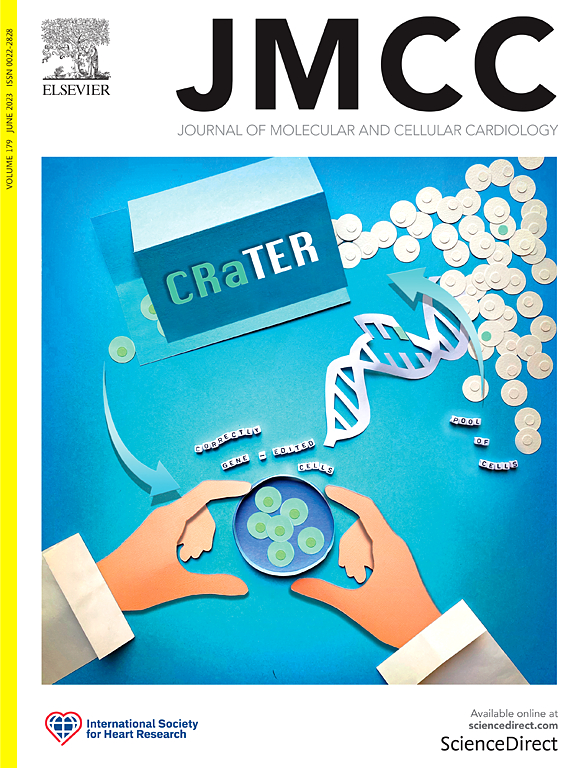Intermedin1–53 improves aging-associated cardiac remodeling and dysfunction via mitochondrial SIRT3-mediated SOD2 deacetylation
IF 4.7
2区 医学
Q1 CARDIAC & CARDIOVASCULAR SYSTEMS
引用次数: 0
Abstract
The aging-associated cardiac remodeling (AACR) is characterized by myocardial hypertrophy, fibrosis and cardiac dysfunction, which could be further aggravated by angiotensin II (Ang II) and pressure-overload in aged people. In this study, we aimed to investigate the roles and mechanisms of intermedin1–53 (IMD1–53), an endogenous peptide, in AACR in aged mice (18 months) with subcutaneous Ang II infusion (1000 ng/kg/min) for 2 weeks via osmotic pump or transverse abdominal aorta constriction (AAC) surgery for 4 weeks. In aged mice undergoing Ang II infusion or AAC surgery, the results showed that the mRNA and protein levels of IMD1–53 were significantly reduced, but the protein levels of its receptor complex components were increased; blood pressure (BP), myocardial hypertrophy, fibrosis, and cardiac dysfunction were notably aggravated; mitochondrial Sirtuin 3 (SIRT3) protein level, superoxide dismutase 2 (SOD2) activity and ATP production were remarkably decreased, but acetylated SOD2 (acSOD2) protein level was markedly increased when compared with the old mice. The above alterations could be effectively alleviated by the subcutaneous IMD1–53 administration (5 ng/kg/min) for 2 or 4 weeks. In Ang II-stimulated cardiomyocytes, IMD1–53 treatment improved Ang II-induced mitochondrial dysfunction and oxidative distress, up-regulated SIRT3 protein expression, and reduced acSOD2 protein level, which were notably weakened by SIRT3 knockdown. Moreover, SIRT3 deletion attenuated the protective effects of IMD1–53 on myocardial hypertrophy, fibrosis, and cardiac dysfunction in aged mice undergoing Ang II infusion. In addition, the effect of IMD1–53 on up-regulating SIRT3 expression was effectively inhibited by the antagonism of IMD1–53 receptor or blocking PI3K/Akt, cAMP/PKA and AMPK signaling pathways in vitro. Taken together, IMD1–53 alleviated AACR and cardiac dysfunction aggravated by Ang II or pressure-overload involving the improvement of mitochondrial oxidative distress through SIRT3-medaiated SOD2 deacetylation.

中间体1 - 53通过线粒体sirt3介导的SOD2去乙酰化改善衰老相关的心脏重塑和功能障碍
衰老相关心脏重构(AACR)以心肌肥大、纤维化和心功能障碍为特征,老年人血管紧张素II (Ang II)和压力过载可进一步加重AACR。在这项研究中,我们旨在研究内源性肽intermedin1-53 (IMD1-53)在老龄小鼠(18个月)AACR中的作用和机制,通过渗透泵皮下注射(1000 ng/kg/min) 2周或腹横主动脉缩窄(AAC)手术4周。结果表明,老龄小鼠经Angⅱ输注或AAC手术后,IMD1-53 mRNA和蛋白水平显著降低,但其受体复合物组分蛋白水平升高;血压(BP)、心肌肥大、纤维化、心功能障碍明显加重;与老龄小鼠相比,线粒体Sirtuin 3 (SIRT3)蛋白水平、超氧化物歧化酶2 (SOD2)活性和ATP生成显著降低,而乙酰化SOD2 (acSOD2)蛋白水平显著升高。IMD1-53皮下给药(5ng /kg/min) 2或4周可有效缓解上述变化。在Ang ii刺激的心肌细胞中,IMD1-53处理改善了Ang ii诱导的线粒体功能障碍和氧化应激,上调了SIRT3蛋白表达,降低了acSOD2蛋白水平,SIRT3敲低显著削弱了acSOD2蛋白水平。此外,SIRT3缺失减弱了IMD1-53对灌注Ang II的老年小鼠心肌肥大、纤维化和心功能障碍的保护作用。此外,IMD1-53在体外可通过拮抗IMD1-53受体或阻断PI3K/Akt、cAMP/PKA和AMPK信号通路,有效抑制其上调SIRT3表达的作用。综上所述,IMD1-53通过sirt3介导的SOD2去乙酰化改善线粒体氧化应激,减轻了Ang II或压力过载加重的AACR和心功能障碍。
本文章由计算机程序翻译,如有差异,请以英文原文为准。
求助全文
约1分钟内获得全文
求助全文
来源期刊
CiteScore
10.70
自引率
0.00%
发文量
171
审稿时长
42 days
期刊介绍:
The Journal of Molecular and Cellular Cardiology publishes work advancing knowledge of the mechanisms responsible for both normal and diseased cardiovascular function. To this end papers are published in all relevant areas. These include (but are not limited to): structural biology; genetics; proteomics; morphology; stem cells; molecular biology; metabolism; biophysics; bioengineering; computational modeling and systems analysis; electrophysiology; pharmacology and physiology. Papers are encouraged with both basic and translational approaches. The journal is directed not only to basic scientists but also to clinical cardiologists who wish to follow the rapidly advancing frontiers of basic knowledge of the heart and circulation.

 求助内容:
求助内容: 应助结果提醒方式:
应助结果提醒方式:


